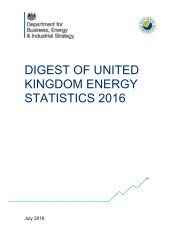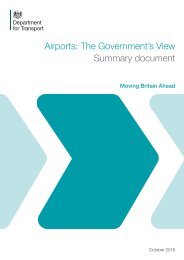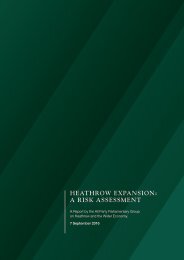20131211-2013.12Reports
20131211-2013.12Reports
20131211-2013.12Reports
Create successful ePaper yourself
Turn your PDF publications into a flip-book with our unique Google optimized e-Paper software.
commented on the chosen location (in the vicinity of a designated paraglider/microlight winchlaunching<br />
area), and, although the Quantum was in fact in transit rather than being operated from this<br />
location, opined that the airtest could sensibly have either been conducted in an area and at a height<br />
that was better deconflicted from other VFR traffic, or an extra crew member could have been carried<br />
to improve lookout in what was see-and-avoid airspace. Members also reiterated the benefit of a<br />
radar based ATS in these circumstances and noted that the Sea King crew were using on-board<br />
equipment to give them SA on other transponding aircraft. In the event, given that the microlight was<br />
not equipped with an SSR transponder, it would not have been seen on the SSR-only Culdrose radar<br />
or in the Sea King. Finally, members also commented that, notwithstanding operational imperatives,<br />
the combination of challenging weather and lack of appropriate ATS may have presented sufficient<br />
risk that the airtest could reasonably have been postponed altogether.<br />
The microlight pilot reported that he had ‘checked NOTAMs’ before take-off, one of which stated that<br />
Culdrose ‘were not offering a service’ that day, and that he therefore did not seek to obtain an ATS<br />
from them. Members agreed that it would have been advantageous for the microlight pilot to have<br />
contacted Culdrose to pass his route details to them so that they, and the aircraft they were<br />
controlling, could have benefited from the increased SA that this would have provided even though a<br />
Traffic Service would not have been possible (given that the microlight was not equipped with an SSR<br />
transponder and that Culdrose were operating SSR-only). However, the Board concluded that the<br />
microlight pilot had been led to believe that Culdrose ‘were not offering a service’ that day, and so his<br />
decision to talk instead to Newquay was understandable, and in fact laudable, in that he had<br />
consciously chosen to communicate his routing and intentions to an ATS unit near his route.<br />
With regard to the RNAS Culdrose NOTAM, the Board noted that there was no record of a NOTAM<br />
being issued for RNAS Culdrose on the date of the Airprox; members therefore wondered whether<br />
the microlight pilot may possibly have read information that had been passed by phone from RNAS<br />
Culdrose to local operators in accordance with their routine procedures. However, regardless of<br />
whether by NOTAM or phone call, the situation regarding SSR-only operations had either been<br />
misinterpreted by the microlight pilot, or had not been clearly conveyed. The Board noted that the<br />
microlight pilot’s flying instructor had also independently confirmed that ‘Culdrose were not offering a<br />
service’, so there was clearly ambiguity of some sort. Ultimately, the Board could not reconcile RNAS<br />
Culdrose’s belief that a NOTAM had been issued when in fact there was no record of such.<br />
The microlight pilot saw the Sea King at range, was able to maintain visual contact, and took avoiding<br />
action from the rotor wash when the Sea King pilot turned right to avoid him. The Sea King pilot was<br />
required to give way but the crew did not see the microlight until just before CPA; the Board therefore<br />
decided that the cause was a late sighting by the Sea King pilot, and, although effective avoiding<br />
action had been taken, safety margins were much reduced below normal.<br />
PART C: ASSESSMENT OF CAUSE AND RISK<br />
Cause:<br />
A late sighting by the Sea King pilot.<br />
Degree of Risk: B.<br />
ERC Score 6 : 101.<br />
6 Although the Event Risk Classification (ERC) trial had been formally terminated for future development at the time of the<br />
Board, for data continuity and consistency purposes, Director UKAB and the UKAB Secretariat provided a shadow<br />
assessment of ERC.<br />
4







